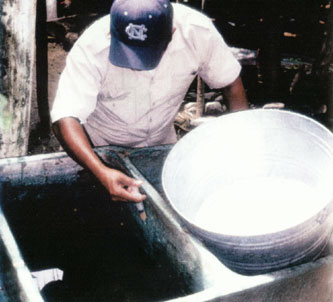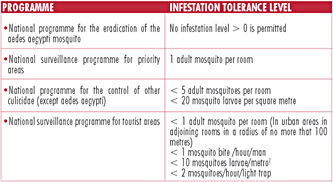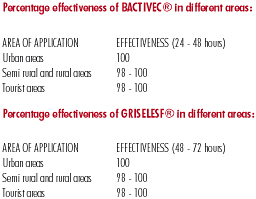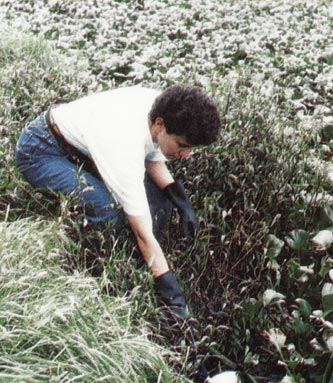BACTIVEC® Y GRISELESF®, Bio-larvicides for mosquito control
In practice
The action of these bacterial insecticides is entirely preventative, since by eliminating the larvae they prevent the emergence of adult insects, which are the direct agents of the transmission of the illnesses to man. Because of their preventative action, these products should be included in national vector control programmes. The programmes should make use of integrated entomological monitoring systems which, by keeping a check on community risks of contracting diseases transmitted by the said carriers, can decide when to intervene and assess the impact they have. In Cuba these products have been part of the following MINSAP Vice Ministry of Hygiene and Epidemiology programmes since 1995:
• National programme for the eradication of the aedes aegypti mosquito.
• Programme for the control of other culicidae.
• National surveillance programme for priority areas.
• Surveillance programme for tourist areas.
The need for controls on these carriers depends on the samples taken by the control systems of each of the above mentioned programmes. The following table shows the infestation tolerance levels of the programmes.
MOSQUITO INFESTATION TOLERANCE LEVELS OF MINSAP PROGRAMMES IN CUBA
STAGES IN A GENERAL CONTROL PROGRAMME FOR HUMAN DISEASE-BEARING MOSQUITOES
STAGE 1 – PRE-TREATMENT
Gathering basic information (1 month)
The necessary information needs to be gathered in collaboration with health authorities in each target area. The information will then be used to give a hygienic – epidemiological – carrier profile of each target area and then to remove the insects.
Examples of information:
• Number of homes and population.
• Number of temporary and permanent breeding areas.
• Species present and density levels before treatment.
• Profile of breeding areas.
• Maps and sketches of the target areas or municipalities.
• Epidemiological data from the target areas for the past 5 years.
• Weather data.
Logistics
Logistics are fundamental to the success of the programme. Unforeseen circumstances may, depending on specific aspects, affect programme costs by between 5-10% of the total.
Capacity building
Those working directly or indirectly in the programme are given a two-week course on the safe use of Griselesf and Bactivec, larvicide action, spraying techniques, control, and monitoring.
Health education and community participation
The media, health talks, publicity, etc. are used to gain the support of the population in implementing the programme, produce changes in community life style that generate a greater awareness of the risks of contracting diseases, and foster participation in the fight against disease carriers.
STAGE 2 – SAMPLING AND APPLICATION OF BIO-LARVICIDES
Pre-treatment sampling
Pre-treatment samples are taken from all existing or potential breeding areas, whether they be natural or artificial, permanent or temporary. In each of these, fixed trapping stations are selected to collect samples. These are used to determine relative larva density before and after periodic bio-larvicide application to find out the percentage reduction of larva populations. Records are kept on special forms. Every three months, experts asses and analyse the progress of the programme.
Treatment of mosquito breeding areas
All existing breeding grounds are treated with Griselesf or Bactivec, depending on the area, mosquito species, population densities and duration of habitat (permanent or temporary), using appropriate equipment.
STAGE 3 – DATA ANALYSIS AND DRAFTING OF FINAL REPORT
This final stage of the programme lasts two months. The final report should contain statistics to show how successful the programme has been and details on setting up an epidemiological monitoring system that gives plenty of warning time for action to be taken so as to give sustainable results.
The practical results that have been obtained in almost two decades of experience in the employment of GRISELESF® and BACTIVEC® depend directly on areas where they have been applied, since this has a decisive influence on the final effectiveness of the application.









 COUNTRY OF ORIGIN
COUNTRY OF ORIGIN